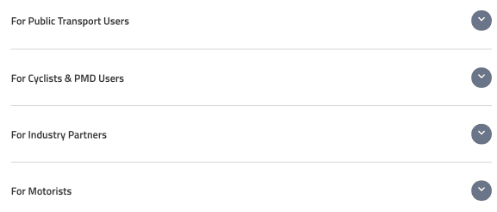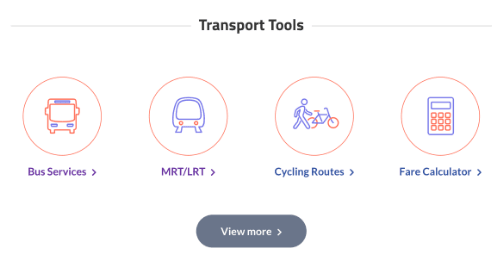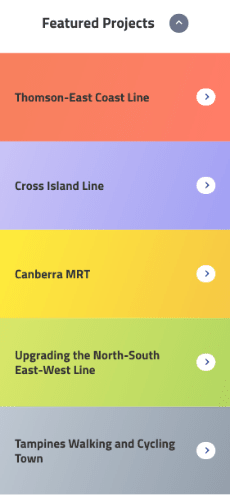West Coast Extension to Proceed; New Rail Lines Under Study to Expand
Rail Network Additional Investments Over 5 Years to Strengthen Rail Reliability
Singapore’s rail network is set to expand as announced at the Ministry of Transport’s Committee of Supply debate today. LTA plans to proceed with the West Coast Extension which extends the Jurong Region Line to connect with the Circle Line and Cross Island Line. Feasibility studies are also ongoing for new rail lines to further improve access to public transport. Concurrent with these expansion efforts, additional investments will be made to support tripartite efforts to maintain the reliability of our existing rail network.
Ongoing rail projects
2. Rail projects across the island continue to make steady progress. Hume Station on the Downtown Line (DTL) opened for passenger service on 28 February 2025, while phase 2 of the Cross Island Line (CRL) is expected to break ground in the first half of 2025. Circle Line (CCL) stage 6, which closes the circle between HarbourFront and Marina Bay stations via three new stations, is due to be completed in the first half of 2026. Another three new stations as part of Thomson-East Coast Line Stage 5 (TEL5) and Downtown Line 3 extension (DTL3e) are on track to open in the second half of 2026. We have also commenced electrical, mechanical and track works for Jurong Region Line Stage 1 (JRL1), which is on track to open in 2027, followed by the next two stages of the JRL in 2028 and 2029. From 2030, we will progressively open our eighth MRT Line, the Cross Island Line.
3. As we press forward with our ongoing rail projects, the Government remains committed to our long-term vision under the Land Transport Master Plan of having 8 in 10 households be within a 10-minute walk from a train station by the 2030s. We will continue to expand the rail network to better serve residents, especially in areas with new and growing developments.
West Coast Extension
4. LTA has been studying a West Coast Extension (WCE) to further improve rail connectivity in the West. We plan to implement the WCE in two phases:
a) The first phase will extend the JRL from Pandan Reservoir Station to connect with the CRL at West Coast Station by the late 2030s.
b) In the second phase, our current plan is to further extend the JRL from West Coast Station to connect with the CCL at Kent Ridge station by the early 2040s.
5. The WCE will provide residents in the West time savings of up to 20 minutes for journeys towards the city centre. It will also strengthen the resilience of our rail network by providing alternative travel options to the city centre via the Circle Line, as well as to other parts of the island via the Cross Island Line. More details on the alignment of the line and station locations will be announced at a later date.
Feasibility studies for new rail lines
6. In the Land Transport Master Plan 2040, the Government had identified a proposed new line for feasibility studies. This rail line, tentatively called the Seletar Line, could serve areas such as Woodlands, Sembawang, Sengkang West, Serangoon North, Whampoa, Kallang, and the Greater Southern Waterfront. Feasibility studies are currently ongoing.
7. In addition, we have also identified another corridor with potential for a new rail line, tentatively called the Tengah Line. Feasibility studies are ongoing to assess how such a line could supplement the transport network in the west and northwest regions to serve areas such as Tengah, Bukit Batok, Queensway, and Bukit Merah.
8. We have also preliminarily assessed that these two potential rail lines could meet at the Greater Southern Waterfront. LTA’s feasibility studies will therefore take into consideration the possibility of linking both lines into a single line. If studies confirm that these lines are feasible, we expect to complete them in phases from the 2040s. The lines are estimated to serve more than 400,000 households. More details will be provided as we make progress on the feasibility studies.
Strengthening Rail Reliability
9. As we plan ahead to expand our rail network, we want to ensure that the rail network remains safe, reliable and resilient. Through strong tripartite efforts, we have consistently achieved our target of at least 1 million mean kilometres between failure (MKBF) for our rail network since 2019. However, maintaining high reliability standards will become more challenging as our network expands and we have to maintain both newer and older systems and assets.
10. To support tripartite efforts to strengthen rail reliability, the Government intends to invest up to an additional $1 billion over the next five years to enhance the management of rail assets and improve the capabilities of our rail workforce. This investment reinforces the strong collaboration between LTA and the tripartite partners to develop a reliable public transport system and ensure smoother and more efficient journeys for commuters.
11. We will strengthen the management of rail operating assets by investing in condition monitoring capabilities that allow for more proactive and targeted maintenance. This will complement investments to carry out targeted pre-emptive replacements of subsystems and components to better sustain our assets. We will also invest in new technologies that enhance maintenance efficiency and effectiveness across the sector.
12. We will also invest in transforming and levelling up the rail workforce, who play a crucial role in the maintenance and smooth operations of the MRT system. We will strengthen training programmes and provide more opportunities for rail workers to upgrade their skills, while supporting public transport operators as they drive workforce and operations transformation to be more future-ready. We will also create more opportunities for our rail workforce and leaders to learn from the best overseas metro systems and international experts.
13. Together, these efforts to expand the rail network, enhance the management of rail assets, and upskill our rail workforce, will allow us to continue delivering convenient, reliable and resilient public transport for our commuters.
Annex: Schematic of Singapore’s Existing and Upcoming Rail Lines
















